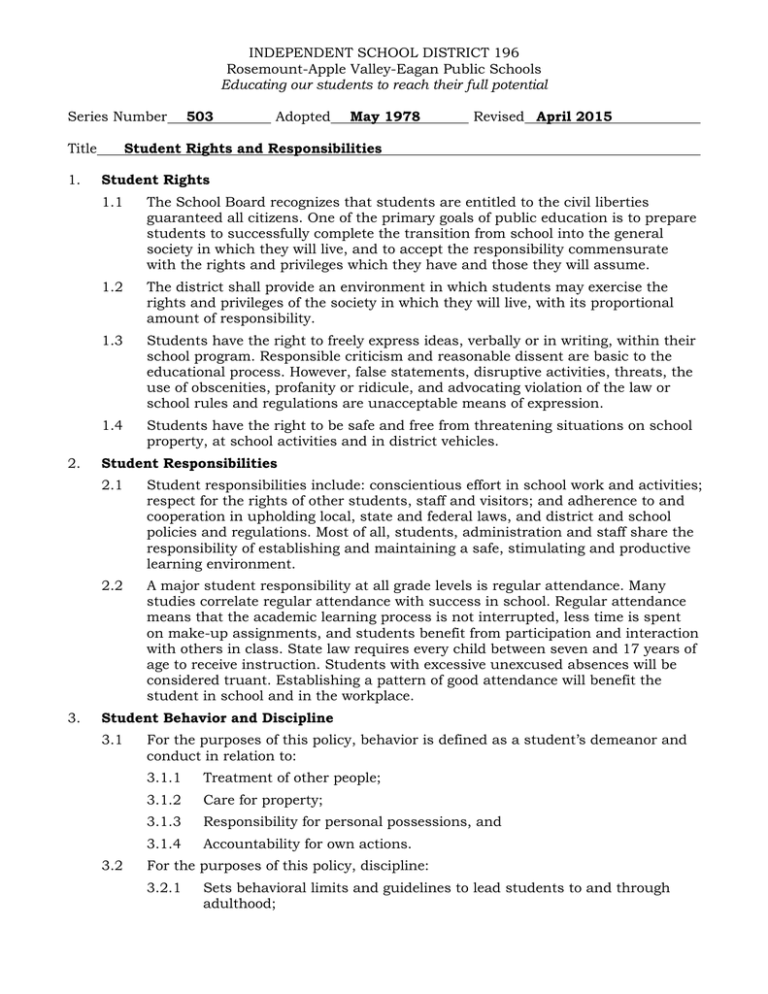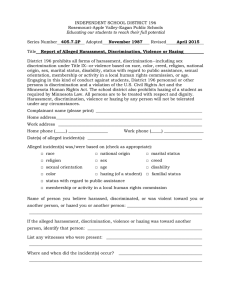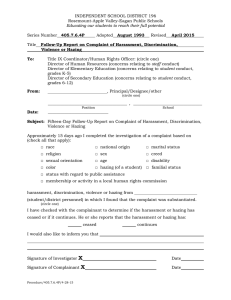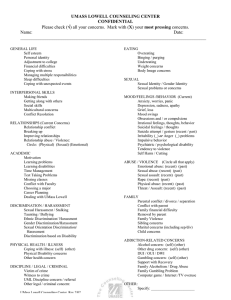
INDEPENDENT SCHOOL DISTRICT 196
Rosemount-Apple Valley-Eagan Public Schools
Educating our students to reach their full potential
Series Number
Title
1.
2.
3.
503
Adopted
May 1978
Revised April 2015
Student Rights and Responsibilities
Student Rights
1.1
The School Board recognizes that students are entitled to the civil liberties
guaranteed all citizens. One of the primary goals of public education is to prepare
students to successfully complete the transition from school into the general
society in which they will live, and to accept the responsibility commensurate
with the rights and privileges which they have and those they will assume.
1.2
The district shall provide an environment in which students may exercise the
rights and privileges of the society in which they will live, with its proportional
amount of responsibility.
1.3
Students have the right to freely express ideas, verbally or in writing, within their
school program. Responsible criticism and reasonable dissent are basic to the
educational process. However, false statements, disruptive activities, threats, the
use of obscenities, profanity or ridicule, and advocating violation of the law or
school rules and regulations are unacceptable means of expression.
1.4
Students have the right to be safe and free from threatening situations on school
property, at school activities and in district vehicles.
Student Responsibilities
2.1
Student responsibilities include: conscientious effort in school work and activities;
respect for the rights of other students, staff and visitors; and adherence to and
cooperation in upholding local, state and federal laws, and district and school
policies and regulations. Most of all, students, administration and staff share the
responsibility of establishing and maintaining a safe, stimulating and productive
learning environment.
2.2
A major student responsibility at all grade levels is regular attendance. Many
studies correlate regular attendance with success in school. Regular attendance
means that the academic learning process is not interrupted, less time is spent
on make-up assignments, and students benefit from participation and interaction
with others in class. State law requires every child between seven and 17 years of
age to receive instruction. Students with excessive unexcused absences will be
considered truant. Establishing a pattern of good attendance will benefit the
student in school and in the workplace.
Student Behavior and Discipline
3.1
3.2
For the purposes of this policy, behavior is defined as a student’s demeanor and
conduct in relation to:
3.1.1
Treatment of other people;
3.1.2
Care for property;
3.1.3
Responsibility for personal possessions, and
3.1.4
Accountability for own actions.
For the purposes of this policy, discipline:
3.2.1
Sets behavioral limits and guidelines to lead students to and through
adulthood;
Policy 503
Page 2
3.2.2
Develops individual respect for law, authority, property, and the rights of
others and self, and
3.2.3
Develops a mature individual capable of self-control and direction.
3.3
Disciplinary efforts are to be as positive as possible, and are to include
recognizing and strengthening appropriate behavior.
3.4
Every student and employee in District 196 is entitled to learn and work in a safe
school environment. Therefore, the district is responsible for making reasonable
rules and regulations governing student behavior and conduct, and maintaining
proper control and discipline. To ensure this, it is important that the district
establish and communicate clear student behavior expectations and support
these expectations with appropriate consequences that are applied consistently.
District employees are expected to deal with students fairly and honestly, and to
treat all students with courtesy and respect.
3.5
In establishing a suitable learning environment, with proper control and
discipline, the general maturation of the students involved must be considered.
Within this context, district officials must protect the health and well-being of all
students while safeguarding individual rights.
3.6
Students are expected to behave in accordance with federal, state and local laws
and rules; and district and school policies, rules and regulations, and in a way
that respects the rights and safety of others. Staff will take corrective action to
discipline a student and/or to modify a student’s behavior when a student’s
behavior does not fall within these parameters.
3.6.1
Actions which may be used by district staff to discipline students and/or
encourage them to modify their behavior include but are not limited to:
student conference, parent or guardian notification, parent or guardian
conference, fine, restitution, detention, removal from class, in-school
suspension, dismissal from school, out-of-school suspension, exclusion,
expulsion, referral to law enforcement authorities and recommendation
of alternative community services. Administrators may apply less severe
consequences after considering intent or other extenuating
circumstances.
3.6.2
The use of corporal punishment is not permitted. Corporal punishment is
defined as inflicting physical hurt upon a child in order to punish her or
him for misconduct.
3.6.3
When an incident occurs in which one or more students have been
physically or emotionally harmed by the misbehavior of another
student(s), district staff shall be sensitive to the need to provide support
to the victim(s) and to inform their parent(s) or guardian(s) about the
incident.
3.6.4
School staff may report suspected criminal misconduct by a student to
law enforcement. Law enforcement officers shall be permitted to carry out
necessary law enforcement functions in the schools, including the
removal of a student from school grounds in appropriate circumstances.
3.6.5
The school district will cooperate and coordinate with county crisis
service providers as appropriate and feasible to respond to the needs of
students whose behavior may be addressed by crisis intervention.
Policy 503
Page 3
4.
3.7
Physical Restraint - A teacher or school principal may use reasonable force when
it is necessary under the circumstances to correct or restrain a student or
prevent bodily harm or death to another. Other school district employees, school
bus drivers, or other agents of a district may use reasonable force when
necessary under the circumstances to restrain a student or prevent bodily harm
or death to another. Special care will be taken with students with disabilities to
follow any guidelines for physical restraint which may be written into their
individual education plan (IEP). Physical holds of students with IEPs shall only be
done in an emergency, by authorized personnel, in conformance with the law on
restrictive procedures and the district’s restrictive procedures plan.
3.8
The policies in sections 3.1-3.7 above will be adjusted, as required by federal and
state laws and regulations and by the student’s individual education plan (IEP),
for special education students. For more information, refer to appropriate
sections of Administrative Regulation 503.3AR, Student Behavior Expectations
and Consequences for Misbehavior, other district policies and regulations related
to special education students and the District 196 Child Study Handbook.
Prohibition of Harassment, Discrimination (Including Sex Discrimination under
Title IX), Violence or Hazing
4.1
District 196 is committed to maintaining an educational and employment
environment that is free from harassment, discrimination, violence or hazing.
District 196 prohibits any form of harassment, discrimination, violence or hazing,
as these terms are defined herein.
4.1.1
It is a violation of this policy for any District 196 student or staff to
harass an employee, student, visitor or other person through conduct or
communication of a sexual nature or regarding sex, race, religion, color,
creed, national origin, marital status, familial status, disability, status
with regard to public assistance, sexual orientation or age as defined by
this policy and supporting administrative regulations.
4.1.2
It is a violation of this policy for any District 196 student or staff to
inflict, threaten to inflict or attempt to inflict violence based on sex, race,
religion, color, creed, national origin, marital status, familial status,
disability, status with regard to public assistance, sexual orientation or
age upon any employee, student, visitor or other person.
4.1.3
It shall be a violation of this policy for any District 196 student or staff to
plan, direct, encourage, aid or engage in hazing. It will also be a violation
of this policy for any staff to condone or fail to report any hazing.
4.1.4
It shall be a violation of this policy for any District 196 student or staff to
engage in discrimination based on sex, race, religion, color, creed,
national origin, marital status, familial status, disability, status with
regard to public assistance, sexual orientation or age upon any employee,
student, visitor or other person.
4.1.4.1 District 196 shall comply with state and federal laws prohibiting
discrimination, including Title IX of the Educational
Amendments of 1972, Title VI of the Civil Rights Act of 1964, the
Age Discrimination Act of 1975, Section 504 of the Rehabilitation
Act of 1973, the Americans with Disabilities Act of 1991 and the
Minnesota Human Rights Act.
Policy 503
Page 4
4.1.4.2 No person protected by these laws shall, on the grounds of race,
color, creed, religion, national origin, sex, marital status, familial
status, disability, status with regard to public assistance, sexual
orientation or age be excluded from participation in, be denied
the benefits of or be otherwise subjected to discrimination in
employment or under any educational program or activity
operated by the district.
4.1.4.3 The school district complies with a number of state and federal
laws prohibiting discrimination. Copies of these laws are available
for no charge in each district building and on the district website.
4.1.5
The district will act to investigate all complaints, either formal or
informal, verbal or written, of harassment, discrimination, violence or
hazing, and to discipline or take appropriate action against any
employee, student or other district personnel who is found to have
violated this policy.
4.1.6
District 196 has written procedures for reporting and investigating all
complaints of harassment, discrimination, violence or hazing, which
provide for appropriate disciplinary action based on results of the
investigation and shall communicate these procedures to district personnel
and students. The district has appointed the Title IX Coordinator/Human
Rights Officers who are charged with receiving, investigating and working
to remedy complaints of harassment, discrimination, violence or hazing.
Among other things, they are responsible for coordinating the district’s
compliance with applicable discrimination laws, which includes overseeing
Title IX complaints relating to sex discrimination and identifying and
addressing any problems that arise during the review of such complaints.
4.1.6.1 Specifically, the following persons are appointed as Title IX
Coordinators/Human Rights Officers and serve as both the
district’s Title IX Coordinator, as well as its Human Rights
Officers for complaints as follows:
4.1.6.1.1
For complaints involving harassment, discrimination,
violence or hazing by district personnel contact:
Director of Human Resources
3455 153rd Street West
Rosemount, MN 55068-4946
651-423-7859
4.1.6.2.1
For complaints involving harassment, discrimination,
violence or hazing by a student, contact the
appropriate level director:
Director of Elementary Education (grades k-5)
3455 153rd Street West
Rosemount, MN 55068-4946
651-423-7782
or
Policy 503
Page 5
Director of Secondary Education (grades 6-12)
3455 153rd Street West
Rosemount, MN 55068-4946
651-423-7712
4.1.6.2 A complaint made to one Title IX Coordinator/Human Rights
Officer that falls within the province of another Title IX
Coordinator/Human Rights Officer, shall be forwarded to the
appropriate Title IX Coordinator/Human Rights Officer.
4.1.6.3 When appropriate, in fulfilling their duties, the Title IX
Coordinator/Human Rights Officers may delegate investigational
and other responsibilities to employees or agents of the district.
4.1.6.4 Inquiries concerning the application of Title IX may be referred to
the appropriate Title IX Coordinator/Human Rights Officer or to
the Office of Civil Rights, which may be reached at
1800-421-3481 or ocr@ed.gov.
4.1.7
The superintendent develops and implements programs and processes
to:
4.1.7.1 Assure district compliance in employment or educational
programs, athletics, counseling, activities and facilities;
4.1.7.2 Evaluate district operations in terms of applicable federal and
state laws prohibiting discrimination, harassment, violence and
hazing;
4.1.7.3 Set up a Title IX grievance process and appoint the district Title
IX Coordinator/Human Resource Officers, and
4.1.7.4 Set up a Section 504 grievance process, and appoint a Section
504 grievance officer.
4.1.8
Employees and students are responsible for reporting any evidence of
discrimination, harassment, violence or hazing on the basis of race, color,
creed, religion, national origin, sex, marital status, familial status,
disability, status with regard to public assistance, sexual orientation or age
in the district. The district has developed regulations appointing
appropriate staff persons to whom reports shall be made. Appropriate
action may be taken against all who fail to report instances of
discrimination, harassment, violence or hazing.
4.1.9
This policy does not deny the right of any individual to pursue other
avenues of recourse which may include filing charges with the Minnesota
Department of Human Rights, initiating civil action or seeking redress
under state criminal statutes and/or federal law.
4.1.10 Nothing in this policy shall preclude teaching about issues related to sex,
race, religion, color, creed, national origin, marital status, familial status,
disability, status with regard to public assistance, sexual orientation or
age issues as part of the school curriculum.
4.1.11 Retaliation - The district shall discipline or take appropriate action
against any student or district personnel who retaliates against any
person who reports alleged harassment, discrimination, violence or
hazing, or against any person who testifies, participates in or assists in
an investigation, or who testifies, assists or participates in a proceeding
or hearing relating to such harassment, discrimination, violence or
hazing. Retaliation includes, but is not limited to, any form of
intimidation, reprisal or harassment.
Policy 503
Page 6
4.1.12 All persons in the district affected by this policy shall be notified about this
policy.
4.2
Definitions
4.2.1
Sexual Harassment – Sexual harassment is a form of sex discrimination
and includes unwelcome sexual advances, requests for sexual favors,
sexually-motivated physical conduct, other verbal or physical conduct or
communication of a sexual nature, including communication
accomplished through the use of technology, including sexting and some
forms of cyberbullying when (a) submission to that conduct or
communication is made a term or condition, explicitly or implicitly, of
employment, public services or education; or (b) submission to or
rejection of that conduct or communication by an individual is used as a
factor in decisions affecting that individual’s employment, public services
or education; or (c) that conduct or communication has the purpose or
effect of substantially interfering with an individual’s employment, public
services or education, or creating an intimidating, hostile or offensive
employment, public services or educational environment.
4.2.1.1 In compliance with 4.2.1 above, while sexual harassment
encompasses a wide range of conduct, some examples of conduct
which may be prohibited include:
4.2.1.1.1
Promising, directly or indirectly, a reward, if the
student or employee complies with a sexually
oriented request;
4.2.1.1.2
Threatening, directly or indirectly, retaliation if the
student or employee refuses to comply with a
sexually oriented request;
4.2.1.1.3
Denying, directly or indirectly, an employment or
education-related opportunity, if the student or
employee refuses to comply with a sexually oriented
request;
4.2.1.1.4
Engaging in unwelcome sexually suggestive
conversation, physical contact or touching of another
student or employee;
4.2.1.1.5
Sexual exploitation and sexually based stalking
and/or bullying;
4.2.1.1.6
Displaying and sharing pornographic or sexually
oriented materials;
4.2.1.1.7
Engaging in indecent exposure;
4.2.1.1.8
Making unwelcome sexual or romantic advances
toward a student or employee and persisting despite
the student or employee’s rejection of the advances,
or
Policy 503
Page 7
4.2.1.1.9
Sexual misconduct, which is any non-consensual
physical contact of a sexual nature. It may include
any intentional sexual touching, however slight,
without consent.
4.2.1.2 Sexual harassment can be physical and/or psychological in
nature. An aggregation of a series of incidents can constitute
sexual harassment even if one of the incidents considered
separately would not rise to the level of harassment.
4.2.1.3 Sexual harassment can involve males and females being
harassed by members of either sex. Although sexual harassment
sometimes involves a person in a greater position of authority as
the harasser, individuals in positions of lesser or equal authority
also can be found responsible for engaging in prohibited
harassment.
4.2.2
Sexual Violence is a physical act of aggression or force or threat of
aggression which involves the touching of another person’s intimate parts,
or forcing a person to touch any person’s intimate parts.
4.2.3
Harassment and Violence based on sex, race, religion, color, creed,
national origin, marital status, familial status, disability, status with
regard to public assistance, sexual orientation or age:
4.2.3.1 Harassment consists of physical or verbal conduct or
communication, including electronic communication that is
demeaning or hostile to an individual’s status related to one or more
of the categories listed in section 4.2.3 above when:
4.2.3.1.1
Submission to that conduct or communication is
made a term or condition, explicitly or implicitly, of
employment, public services or education, or
4.2.3.1.2
Submission to or rejection of that conduct or
communication by an individual is used as a factor
in decisions affecting that individual's employment,
public services or education, or
4.2.3.1.3
That conduct or communication has the purpose or
effect of substantially interfering with an individual's
employment, public services or education, or creating
an intimidating, hostile or offensive employment,
public services or educational environment.
4.2.3.2 Violence is a physical act of aggression or assault upon another
because of, or in a manner reasonably related to, an individual's
status in relation to one or more of the categories listed in
section 4.2.3 above.
4.2.4
Hazing – Hazing means committing an act against a student, or coercing
a student into committing an act, that creates a substantial risk of harm
to a person in order for the student to be initiated into or affiliated with a
student organization. Hazing may occur on or off school property and
during or outside of school hours.
4.2.5
Discrimination – Discrimination means to segregate or separate on the
basis of an individual’s sex, race, religion, color, creed, national origin,
marital status, familial status, disability, status with regard to public
assistance, sexual orientation or age, except where authorized by law.
Policy 503
Page 8
5.
Prohibition of Bullying and Intimidation
5.1
Students have the right to be safe and free from threatening situations on school
property, at school activities and in district vehicles. Bullying interferes with
students’ ability to learn and teachers’ ability to educate students in a safe
environment. To the extent bullying affects the educational environment of
schools, it is the school district’s intent to prevent bullying from occurring, and to
investigate and respond to bullying that has not been prevented.
5.2
District 196 defines bullying as intimidating, threatening, abusive or harming
conduct that is objectively offensive and:
5.3
5.2.1
There is an actual or perceived imbalance of power between the student
engaging in the conduct and the target of the conduct and the conduct is
repeated or forms a pattern, or
5.2.2
Materially and substantially interferes with a student’s educational
opportunities or performance or ability to participate in school functions
or activities or receive school benefits, services or privileges.
District 196 defines cyberbullying as using technology or other electronic
communication including, but not limited to, a transfer of a sign, signal, writing,
image, sound, or date, including a post on a social network Internet website or
forum, transmitted through a computer, cell phone, or other electronic device to
bully another.
5.3.1
6.
Bullying behavior should be reported to a staff member. The district’s
processes for reporting and responding to bullying behavior can be found in
Administrative Regulation 503.8 AR, Bullying Prohibition and Procedure
503.8P, Report of Bullying Behavior.
Acceptable Use of Information Technology
6.1
District 196 offers employees, students and other authorized users (as determined
by the Technology Department and school and department administrators) access
to a variety of information technology resources, including the Internet and email
(at approved grade levels). Internet access in District 196 offers employees and
students vast, diverse, unique and ever-changing resources, and promotes
educational excellence by facilitating resource sharing, innovation and
communication.
6.2
Use of the Internet, district computer networks and computer workstations is a
privilege which may be revoked at any time for abusive conduct.
6.2.1
District networks are a shared resource which are the property of the
school district and, as such, may be subject to district-authorized search
to ensure the integrity of the network and compliance with policies and
laws.
6.2.2
In addition to the district’s standard consequences for student misbehavior
(see Administrative Regulation 503.3AR, Student Behavior Expectations
and Consequences for Misbehavior), any network misuse or illegal activities
will result in temporary or permanent cancellation of network privileges,
contact with the student’s parent or guardian and, if a violation of law has
occurred, contact with law enforcement authorities.
6.2.3
In response for the privilege of accessing the Internet, every Internet user
has the responsibility to respect and protect the rights of every other user
on the Internet, and to act in a responsible, ethical and legal manner.
The administration shall develop regulations for student use of the
Internet.
Policy 503
Page 9
7.
6.2.4
Network users should not assume that stored data and files are private.
Network storage will be treated like school lockers. Network administrators
may review files and communications to maintain system integrity and
ensure that users are utilizing the system responsibly.
6.2.5
Access to the Internet is given to students who agree to act in a
considerate and responsible manner. Parent or guardian permission is
required as described in Administrative Regulation 503.7AR, Acceptable
Use of Information Technology - Students.
6.3
Students, employees and parents are advised that the Internet contains
inappropriate material. The district does not condone the access or use of such
materials in the school environment. Students who knowingly bring such
materials into the school environment on their own initiative, regardless of
format, will be dealt with according to standard district discipline policies. The
district reserves the right to revoke access to the Internet for student misuse.
6.4
In accordance with federal law, the district attempts to block or filter Internet
access to visual depictions that are obscene, pornographic or harmful to minors.
6.5
Concerns from students, parents and guardians about Internet or other computer
network information that is assigned to a student by a teacher or is otherwise part
of teacher-led or directed instruction will be handled in the same manner as
concerns about other instructional resources used in District 196. Policies and
regulations regarding instructional resources, including selection and
reconsideration, also apply to network resources.
Patriotic Exercises – Student appreciation and understanding of the United States of
America, the American heritage and democratic ideals are enhanced by ceremonies and
other observances.
7.1
The Pledge of Allegiance shall be said at every school every school day, and
schools shall regularly involve students in activities and programs to increase
student understanding of the United States of America and its heritage.
7.2
In accordance with the law, individuals who wish to opt out of saying the Pledge
of Allegiance or participation in patriotic exercises due to personal beliefs will be
permitted to do so.
___________________________________________________________________________________________
References: - Minnesota Statute 121A.03, Model policy on sexual, religious, and racial
harassment and violence
- Minnesota Statute 121A.031, School Student Bullying Policy
- Minnesota Statutes 121A.40-121A.56, Pupil Fair Dismissal Act
- Minnesota Statute 121A.69, Hazing
- Minnesota Statutes 125A.094-125A.0942, Restrictive procedures for children
with disabilities
- Minnesota Statute 363A, Minnesota Human Rights Act
- Minnesota Statute 609.321-609.324, Prostitution
- Minnesota Statute 609.341-609.345, Definitions
- Minnesota Statute 626.556, Reporting of maltreatment of minors
-Minnesota Administrative Rules 3525.3700-4700, Due process
- West Virginia State Board of Education vs. Barnette, 63 U.S. Supreme Court
1178 (1943)
- 47 U.S.C. § 254(h), Children’s Internet Protection Act
- 20 U.S.C. 1681 et seq (Title IX of the Educational Amendments of 1972)
- 42 U.S.C. 2000e et seq (Title VI and VII of the Civil Rights Act)
- 42 U.S.C. 12101 et seq (Americans with Disabilities Act of 1991)
- 29 U.S.C. 621 et seq (Age Discrimination in Employment Act of 1967)
- District 196 Restrictive Procedures Plan
Policies/503/04-27-15




